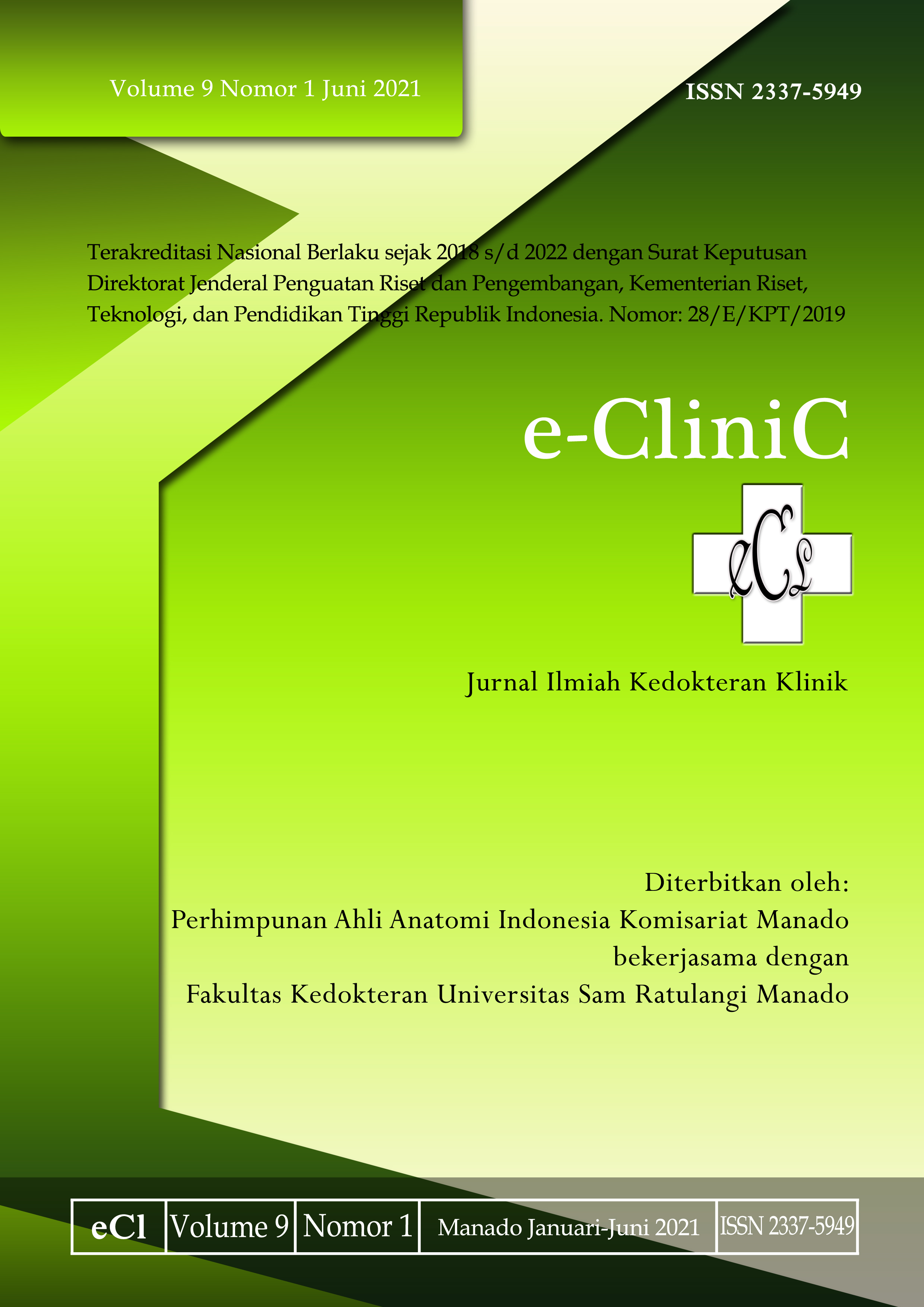Diagnosis dan Tatalaksana Sindrom Hepatorenal
DOI:
https://doi.org/10.35790/ecl.v9i1.31964Abstract
Abstract: Hepatorenal syndrome (HRS) is known as a complication of cirrhosis. Currently, there are no specific laboratory tests to diagnose HRS while liver transplantation, as the definitive therapy, is still problematic due to the poor prognosis and long waiting lists. HRS is typically associated with poor prognosis, with a mortality rate of more than 95%. Without liver transplantation or appropriate vasoconstrictor therapy, the life expectancy was less than 2 weeks. This study was aimed to describe the diagnosis and management of the hepatorenal syndrome. The study design was literature review. Published literature was obtained from three databases: PubMed, ScienceDirect, and Google Scholar. All articles that met the inclusion and exclusion criteria were included in this study. According to five studies regarding the diagnosis, both the incidence and mortality rate of HRS was relatively high (38.1% of all acute kidney injury cases and 64.5%, respectively), even with in-hospital therapy. Five other studies analyzed the management of HRS. It was reported that the mean age of the youngest SHR patients was 53.3 years and the mean oldest age was 65 years. The male gender predominated in all studies (50-79%). In conclusion, the latest revision classified HRS into three groups: HRS-AKI, HRS-AKD, and HRS-CKD. Pharmacological therapies for HRS including terlipressin, octreotide, midodrine, albumin, pentoxifylline, and various combinations of these therapies.                 Â
Keywords: Hepatorenal Syndrome, Diagnosis of HRS, Management of HRS
Abstrak: Komplikasi dari sirosis hati antara lain sindrom hepatorenal (HRS). Sampai saat ini pemeriksaan laboratorium secara spesifik untuk mendiagnosis HRS belum ada. Transplantasi hati secara teori merupakan terapi yang tepat namun masih merupakan masalah utama karena prognosisnya buruk dan daftar tunggu yang lama di pusat transplantasi. Prognosis HRS umumnya buruk dengan angka mortalitas lebih dari 95%, jika tidak melalui transplantasi hati atau terapi vasokonstriktor yang tepat maka rerata angka harapan hidup pasien kurang dari 2 minggu. Penelitian ini bertujuan untuk mengetahui diagnosis dan tatalaksana HRS. Jenis penelitian ialah literature review dengan menggunakan tiga database yaitu PubMed, Science Direct, dan Google Scholar sesuai dengan kriteria inklusi dan eksklusi yang ada. Berdasarkan lima literatur penegakan diagnosis HRS, diketahui insidensi dan angka kematian HRS relatif tinggi (38,1% dari seluruh kasus acute kidney injury (AKI) dan angka kematian 64,5%), meskipun telah mendapatkan terapi di rumah sakit. Lima literatur lainnya tentang tatalaksana SHR, diketahui rerata (mean) usia termuda pasien HRS 53,3 tahun dan rerata (mean) usia tertua 65 tahun, dan yang mendominasi sampel penelitian ialah jenis kelamin laki-laki (50-79%). Simpulan penelitian ini ialah revisi terbaru menunjukkan HRS diklasifikasikan menjadi tiga kelompok: HRS-AKI, HRS-AKD, dan HRS-CKD. Terapi medikamentosa untuk HRS di antaranya terlipressin, oktreotida, midodrine, albumin, pentoxifylline, serta berbagai kombinasi dari terapi tersebut.                          Â
Kata kunci: Â sindrom hepatorenal, diagnosis HRS, tatalaksana HRS
Â
Downloads
How to Cite
Issue
Section
License
COPYRIGHT
Authors who publish with this journal agree to the following terms:
Authors hold their copyright and grant this journal the privilege of first publication, with the work simultaneously licensed under a Creative Commons Attribution License that permits others to impart the work with an acknowledgment of the work's origin and initial publication by this journal.
Authors can enter into separate or additional contractual arrangements for the non-exclusive distribution of the journal's published version of the work (for example, post it to an institutional repository or publish it in a book), with an acknowledgment of its underlying publication in this journal.
Authors are permitted and encouraged to post their work online (for example, in institutional repositories or on their website) as it can lead to productive exchanges, as well as earlier and greater citation of the published work (See The Effect of Open Access).







